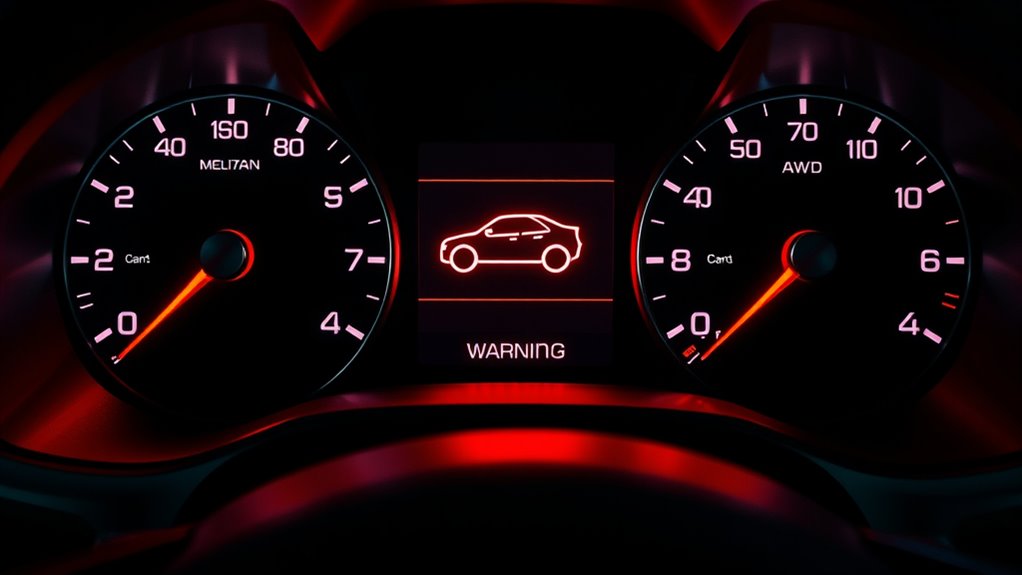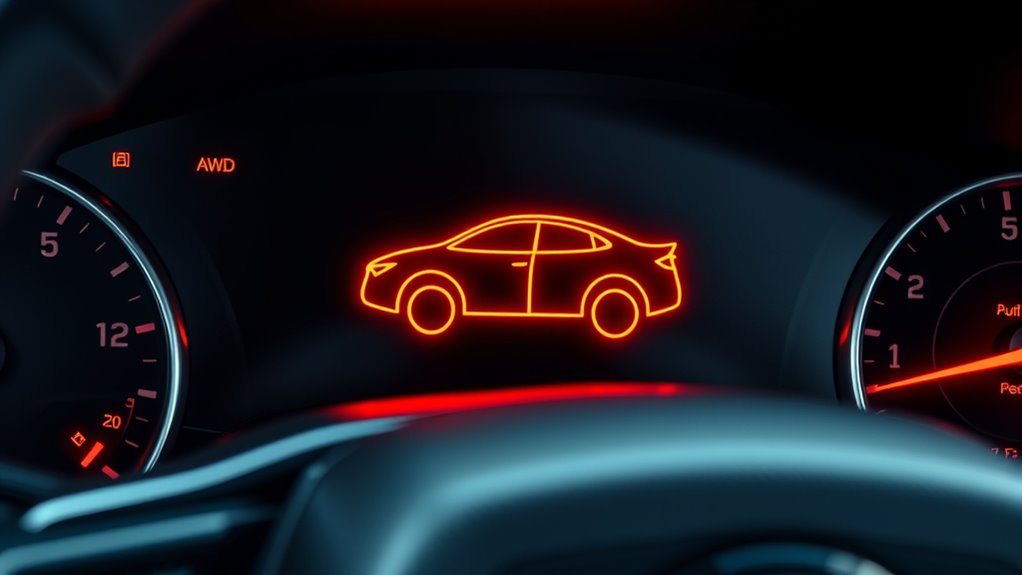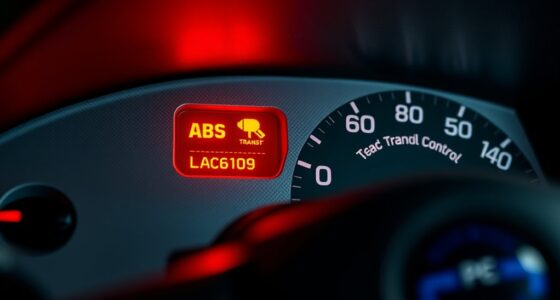When the AWD warning light appears on your dash, it means there’s a problem with your vehicle’s all-wheel-drive system that needs attention. This could be due to sensor issues, mechanical failures, electrical problems, or low fluid levels. Ignoring the warning can reduce traction, cause damage, or compromise safety. If you want to understand what might be wrong and how to fix it, continue exploring the common causes and recommended actions.
Key Takeaways
- An AWD warning light indicates a fault or malfunction in the vehicle’s all-wheel-drive system.
- It may be triggered by sensor issues, mechanical failures, or electrical problems within the AWD components.
- When illuminated, the system might deactivate or limit power distribution to the wheels, reducing traction.
- The warning often appears alongside messages like “Service AWD” or “Check AWD System.”
- Prompt inspection by a qualified mechanic is essential to diagnose and repair the underlying issue.

When you see an AWD warning light appear on your dashboard, it signals that your vehicle’s all-wheel-drive system has detected a problem. This light isn’t something to ignore; it’s your vehicle’s way of alerting you that something isn’t functioning properly within the system designed to enhance traction and stability. The warning could indicate a range of issues, from minor glitches to more serious mechanical failures. Recognizing what this light means and knowing your next steps can prevent further damage and keep you safe on the road.
Typically, the AWD warning light is shaped like a car with four wheels or an abbreviation like “AWD” or “4WD.” When it comes on, it often means the system has been deactivated or is experiencing a fault. Modern vehicles rely on sensors and electronic control units to monitor the health of the AWD system. If a sensor detects a malfunction—perhaps a problem with the transfer case, differential, or wheel sensors—the system may shut itself down to prevent damage.
The AWD warning light indicates system deactivation due to sensor or component malfunctions.
As a result, you might still be able to drive, but the vehicle’s ability to distribute power to all four wheels could be compromised. This can lead to reduced traction, especially in slippery or off-road conditions, so it’s important to address the warning promptly.
In many cases, the warning light is accompanied by a message on your dashboard or an alert sound. Some vehicles also display the specific problem, such as “Service AWD” or “Check AWD System.” When you see these alerts, it’s wise to consult your owner’s manual for guidance specific to your make and model.
Often, the issue can be as simple as a loose electrical connection, low fluid levels, or a sensor needing recalibration. However, it could also mean a more complex mechanical failure requiring professional diagnosis and repair.
You shouldn’t just reset the warning light without understanding the cause. If the light flashes or stays on, it’s best to have your vehicle inspected by a qualified mechanic as soon as possible. Ignoring the warning might lead to further damage, higher repair costs, or even unsafe driving conditions, especially if the AWD system is vital for your vehicle’s stability.
Keep an eye on how your vehicle behaves—any unusual vibrations, noises, or loss of traction should be taken seriously. Addressing the warning early helps guarantee your vehicle remains safe and reliable, whether you’re navigating city streets or venturing off-road. For Honda vehicles, especially those with complex electronic systems, understanding system diagnostics can be crucial for timely repairs.
Frequently Asked Questions
Can AWD Warning Lights Turn off on Their Own?
Yes, AWD warning lights can turn off on their own, but it depends on the cause. Sometimes, minor issues like temporary sensor glitches or low fluid levels resolve themselves or reset after restarting your vehicle.
However, if the warning persists, it’s important you have your system checked by a mechanic. Ignoring persistent warnings can lead to more serious problems, so don’t rely solely on the light turning off.
Do AWD Warnings Affect Vehicle Safety Immediately?
Did you know that about 60% of vehicle accidents involve some form of driver inattention?
AWD warnings can impact your safety immediately, as they often signal issues with traction or stability control. When these lights come on, it’s a sign you should drive more cautiously and get your vehicle checked promptly.
Ignoring the warning could compromise your control, especially in slippery or challenging driving conditions.
How Long Can I Drive With an AWD Warning?
You shouldn’t drive long with an AWD warning. It indicates a problem that could worsen, affecting vehicle safety and performance.
If the warning appears, pull over safely and check your owner’s manual. Avoid aggressive driving and sudden turns, which could cause further damage.
It’s best to have a mechanic examine your vehicle promptly to prevent more costly repairs and ensure your safety on the road.
Are AWD Warning Lights Linked to Specific Vehicle Models?
Yes, AWD warning lights are often linked to specific vehicle models. Manufacturers design warning systems tailored to their AWD systems, so the indicator may look different or trigger under different conditions depending on your make and model.
It’s crucial to consult your owner’s manual to understand what the warning means for your vehicle. If the light stays on, you should have your car inspected by a professional to prevent potential damage.
What Is the Cost to Repair AWD System Warnings?
You might be surprised, but the cost to repair AWD system warnings varies widely. It could be a simple sensor replacement costing a few hundred dollars, or a more complex issue like a faulty transfer case that runs into thousands.
The real expense depends on what’s causing the warning. To avoid surprises, get a professional diagnosis promptly, so you know exactly what’s needed and can plan your budget accordingly.
Conclusion
Seeing an AWD warning on your dash isn’t something to ignore. It could indicate a minor glitch or a serious issue that needs quick attention. Did you know that nearly 30% of vehicle breakdowns are caused by AWD system problems? Staying alert and addressing warnings promptly can save you from costly repairs down the line. Always consult your owner’s manual or a professional mechanic to keep your drive safe and smooth.









